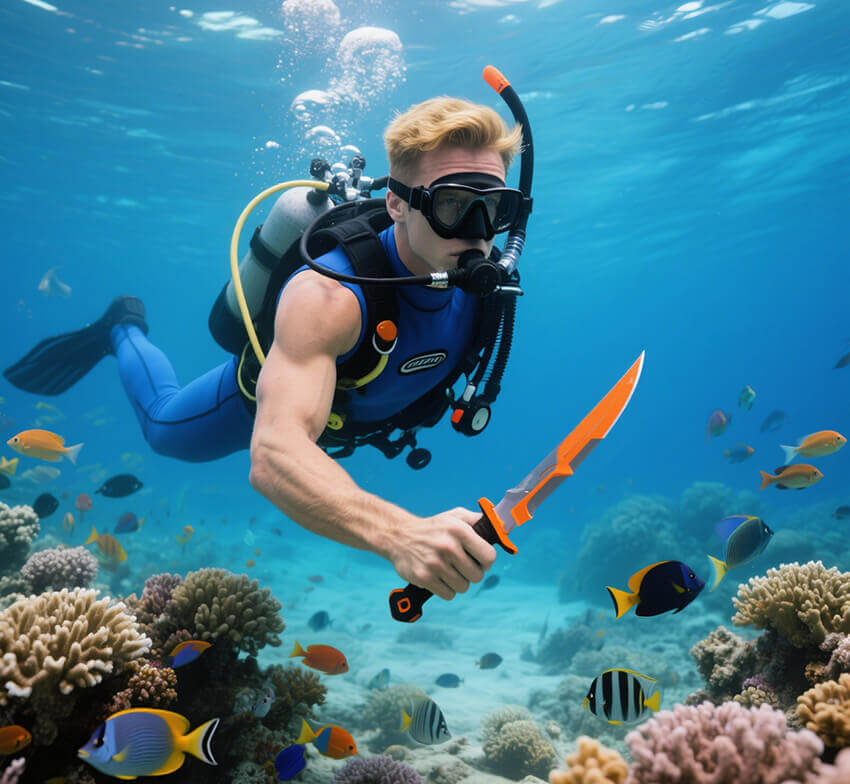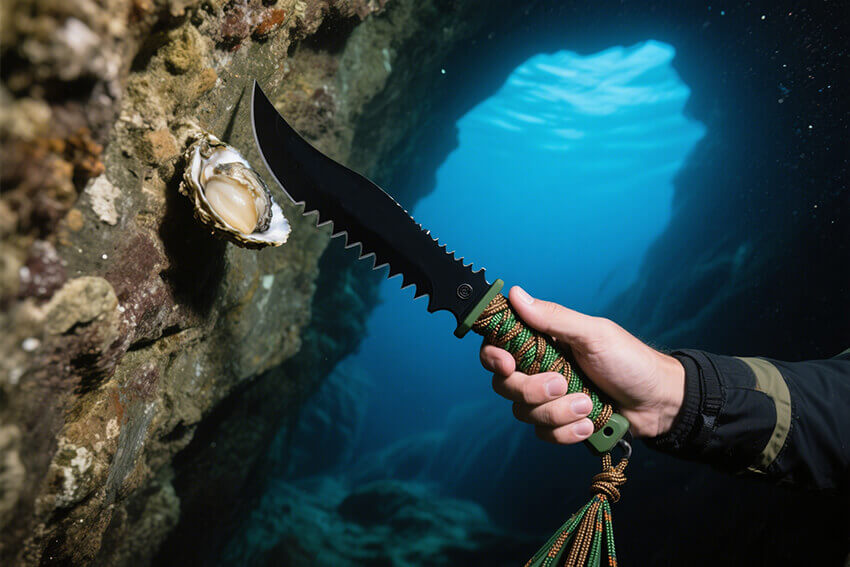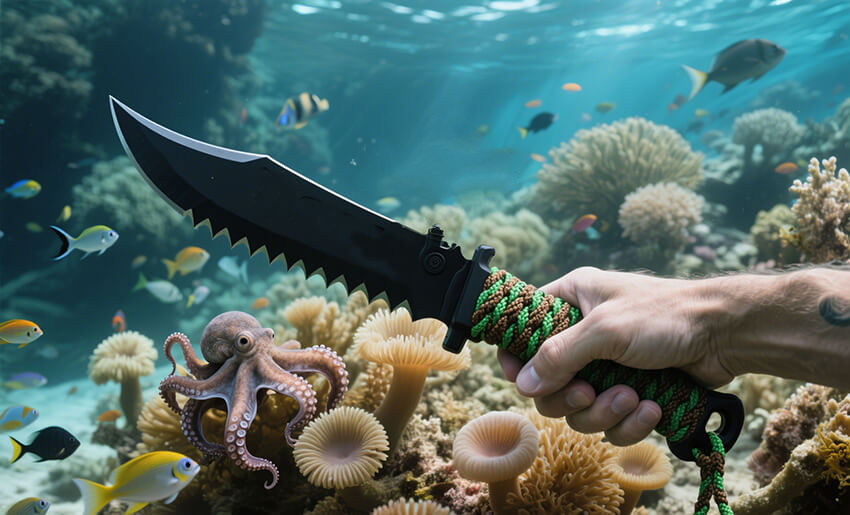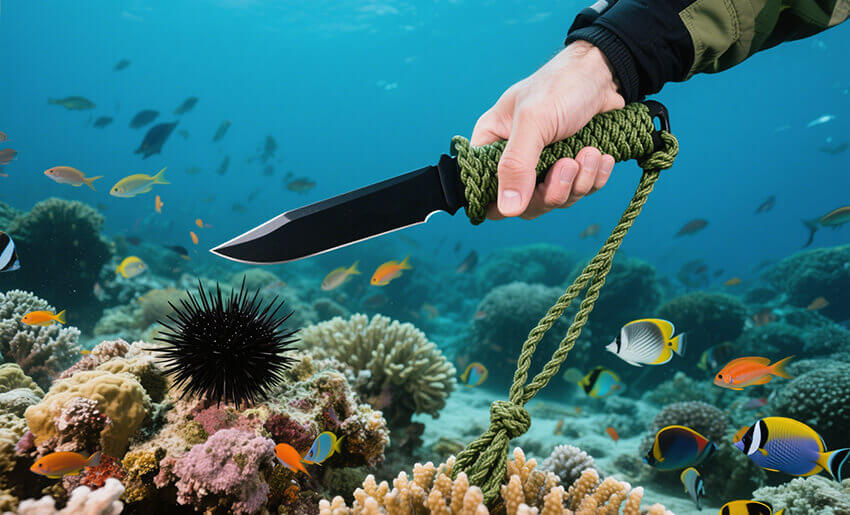![]() Windy
Windy
 WeChat
WeChat
 WhatsApp
WhatsApp
Click:257 seen
Choosing a diving knife that suits you requires comprehensive consideration of the diving scenario, usage requirements, personal habits and professional standards. The following provides a detailed guide from core dimensions to help divers precisely match the equipment:
Ⅰ. Determine the knife function based on the diving type
|
|
|
| Leisure snorkeling / Beach diving | Mild cutting (of seaweed, fishing nets), portability | Blade length: 10 - 15 cm. Lightweight design. Single-edge structure. |
| Technical diving / Caving exploration | High-intensity cutting, anti-tangling, multi-functional | Blade length: 15-20 cm. Combination of serrated edge and flat edge. The back of the blade is equipped with a crowbar. |
| Submarine operation / Deep-sea operation | Anti-corrosion, impact resistance, self-defense capability | Titanium alloy material, with blood grooves on the blade, and reinforced design for the handle |
| Cold-water diving | Low-temperature tolerance, anti-slip grip | Rubber / carbon fiber handle, anti-freeze coated blade |

II. Materials and Craftsmanship: The Core of Resistance to Sea Water Corrosion
1. Comparison of Blade Materials
Stainless Steel (such as 440C, 154CM): High cost-effectiveness, strong corrosion resistance, suitable for entry-level diving; disadvantage is slightly lower hardness (HRC 55-58), frequent sharpening required for long-term use.
Titanium Alloy (Ti-6Al-4V): Light weight (45% lighter than steel), non-magnetic, extremely strong resistance to salt fog corrosion, suitable for deep-sea and highly corrosive sea areas; however, the sharpness retention of the blade is slightly weaker, and the price is higher.
Ceramic Coated Stainless Steel: Gears of titanium nitride (TiN) are plated on the surface of stainless steel, hardness is increased to HRC 60+, wear-resistant and resistant to seawater oxidation, such as CRKT M21-14SFG diving knife.
2. Selection of Handle Materials
Rubber / Silicone: Excellent anti-slip performance, even when wearing thick diving gloves, it can be firmly held, suitable for cold water areas or scenarios requiring frequent knife extraction.
Carbon Fiber / Glass Fiber: Lightweight and resistant to high and low temperatures, suitable for technical divers to reduce equipment weight.
Titanium Alloy / Aluminum Alloy: High strength, but feels cold in low temperatures, needs to be paired with anti-slip patterns (commonly seen in professional military diving knives).

III. Structural Design: Detailed Examination from Blade to Scabbard
1. Blade Shape
Single-edge vs Double-edge: Single-edge knives are more suitable for underwater cutting (single-edge blade is sharp on one side, avoiding accidental cutting of equipment), double-edge knives are mostly used for self-defense (such as increasing deterrence when encountering sharks).
Flat-edge vs Sawtooth Edge: Flat-edge is suitable for cutting ropes, seaweed, etc., soft objects; sawtooth edge is good at handling fishing nets, rubber products, etc., which are tough materials, recommend choosing "front flat back sawtooth" combined blade.
2. Ergonomics of the Handle
Must meet "full grip when wearing gloves, not uncomfortable when bare hands", typical designs include:
.Wave-shaped anti-slip patterns (SUUNTO D5 diving knife)
.Finger groove positioning design (avoid deformation due to underwater movement causing the knife to slip)
.Tail hole for hanging rope (coordinated with the previously mentioned rope-bonding system)
3. Scabbard System
Fixation Method: Preferably choose leg-hanging scabbards with quick-release buckles, which can be quickly pulled out of the knife in an emergency; avoid choosing simple scabbards that rely solely on friction for fixation.
Anti-misfire Design: The opening of the scabbard should have locking structures (such as clasps, Velcro double fixation), to prevent accidental blade sliding out during swimming.

IV. Size and Weight: Balancing Portability and Practicality
Blade Length: For leisure diving, recommend 10-15cm; for technical diving, can be relaxed to 15-20cm; knives longer than 20cm require professional training to operate.
Weight Control: Titanium alloy knives usually weigh 200-300g, stainless steel knives about 300-400g; avoid choosing overly heavy styles (such as over 500g may affect buoyancy control).

V. Special Requirements Additional Functions
Survival Assistance: Some knife handles are internally equipped with whistles, fluorescent strips, facilitating signal emission when lost.
Environmental Design: Choose knives without coatings, recyclable materials (such as titanium alloy), avoiding blade coating detachment contaminating marine ecology.

VI. Testing Suggestions
1. Saltwater Test: Soak the knife in 3% saltwater for 24 hours, observe if there are rust spots (high-quality titanium alloy knives should show no change).
2. Simulation of Knife Extraction Training: Test the stability of the scabbard fixation in the swimming pool to ensure that the knife does not loosen during underwater movements.

Summary: Choosing a diving knife is like selecting an "underwater companion". One should consider it from the four dimensions of "scene - material - design - safety". It is better to spend more time studying the parameters rather than choosing a low-quality product just for the sake of saving money. Remember: A suitable diving knife is not only a cutting tool but also a lifeline in the deep sea.
